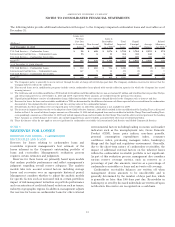American Express 2010 Annual Report Download - page 79
Download and view the complete annual report
Please find page 79 of the 2010 American Express annual report below. You can navigate through the pages in the report by either clicking on the pages listed below, or by using the keyword search tool below to find specific information within the annual report.GAAP requires disclosure of the estimated fair value of all
financial instruments. A financial instrument is defined as
cash, evidence of an ownership in an entity, or a contract
between two entities to deliver cash or another financial
instrument or to exchange other financial instruments. The
disclosure requirements for the fair value of financial
instruments exclude leases, equity method investments,
affiliate investments, pension and benefit obligations,
insurance contracts and all non-financial instruments.
VALUATION TECHNIQUES USED IN MEASURING
FAIR VALUE
For the financial assets and liabilities measured at fair value on a
recurring basis (categorized in the valuation hierarchy table on
the previous page) the Company applies the following valuation
techniques to measure fair value:
Investment Securities (Excluding Retained Subordinated
Securities and the Interest-Only Strip)
•When available, quoted market prices in active markets are
used to determine fair value. Such investment securities are
classified within Level 1 of the fair value hierarchy.
•When quoted prices in an active market are not available, the
fair values for the Company’s investment securities are
obtained primarily from pricing services engaged by the
Company, and the Company receives one price for each
security. The fair values provided by the pricing services are
estimated using pricing models, where the inputs to those
models are based on observable market inputs. The inputs to
the valuation techniques applied by the pricing services vary
depending on the type of security being priced but are
typically benchmark yields, benchmark security prices,
credit spreads, prepayment speeds, reported trades and
broker-dealer quotes, all with reasonable levels of
transparency. The pricing services did not apply any
adjustments to the pricing models used. In addition, the
Company did not apply any adjustments to prices received
from the pricing services. The Company classifies the prices
obtained from the pricing services within Level 2 of the fair
value hierarchy because the underlying inputs are directly
observable from active markets or recent trades of similar
securities in inactive markets. However, the pricing models
used do entail a certain amount of subjectivity and therefore
differing judgments in how the underlying inputs are modeled
could result in different estimates of fair value.
The Company reaffirms its understanding of the valuation
techniques used by its pricing services at least annually. In
addition, the Company corroborates the prices provided by its
pricing services to test their reasonableness by comparing their
prices to valuations from different pricing sources as well as
comparing prices to the sale prices received from sold securities.
Refer to Note 6 for additional fair value information.
Retained Subordinated Securities
As of January 1, 2010, pursuant to changes in GAAP governing
accounting for transfers of financial assets, the Company no
longer has retained subordinated securities. The fair value of the
Company’s retained subordinated securities was determined
using discounted cash flow models. The discount rate was
based on an interest rate curve observable in the marketplace
plus an unobservable credit spread for risks associated with
these securities and other similar financial instruments. The
Company classified such securities as Level 3 in the fair value
hierarchy because the credit spreads were not observable due to
market illiquidity for these securities and similar
financial instruments.
Interest-Only Strip
As of January 1, 2010, pursuant to changes in GAAP governing
accounting for transfers of financial assets, the Company no
longer has interest-only strips. The fair value of the interest-only
strip was the present value of estimated future positive excess
spread expected to be generated by the securitized loans over the
estimated remaining life of those loans. Management utilized
certain estimates and assumptions to determine the fair value of
the interest-only strip asset, including estimates for finance
charge yield, credit losses, London Interbank Offered Rate
(LIBOR) (which determined future certificate interest costs),
monthly payment rate and discount rate. On a quarterly basis,
the Company compared the assumptions it used in calculating
the fair value of its interest-only strip to observable market data
when available, and to historical trends. The interest-only strip
was classified within Level 3 of the fair value hierarchy due to
the significance of the unobservable inputs used in valuing
this asset.
Derivative Financial Instruments
The fair value of the Company’s derivative financial instruments,
which could be assets or liabilities on the Consolidated Balance
Sheets, is estimated by a third-party valuation service that uses
proprietary pricing models, or by internal pricing models. The
pricing models do not contain a high level of subjectivity as the
valuation techniques used do not require significant judgment,
and inputs to those models are readily observable from actively
quoted markets. The pricing models used are consistently
applied and reflect the contractual terms of the derivatives,
including the period of maturity, and market-based
parameters such as interest rates, foreign exchange rates,
equity indices or prices, and volatility.
Credit valuation adjustments are necessary when the market
parameters, such as a benchmark curve, used to value
derivatives are not indicative of the credit quality of the
Company or its counterparties. The Company considers the
counterparty credit risk by applying an observable forecasted
default rate to the current exposure. Refer to Note 12 for
additional fair value information.
77
AMERICAN EXPRESS COMPANY
NOTES TO CONSOLIDATED FINANCIAL STATEMENTS
























